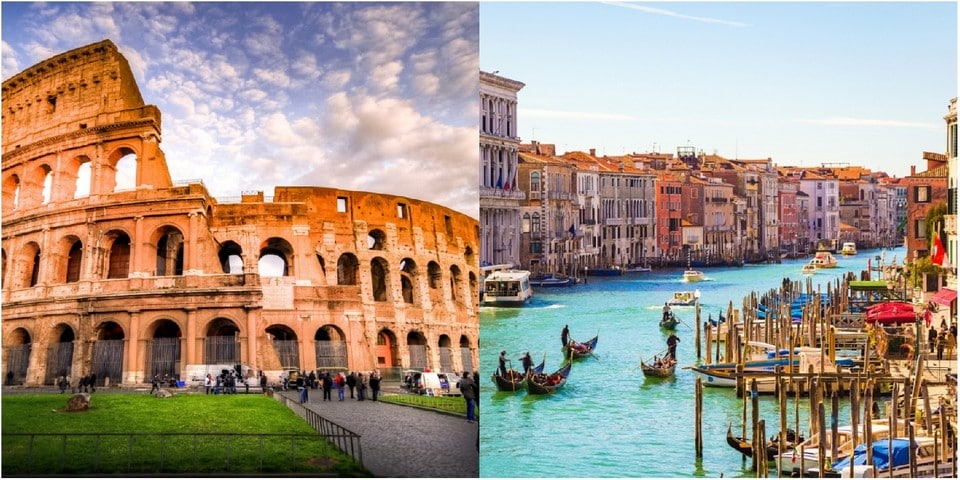

935617 views

The train journey from Venice to Rome is a popular and scenic route that takes you through the heart of Italy. The trip covers a distance of approximately 326 miles (525 kilometers) and offers stunning views of the Italian countryside along the way.
Contents
ToggleHere’s a description of what you can expect during the train ride:
The Italo train is a high-speed train service that operates in Italy. It connects various cities within the country, including the popular route from Venice to Rome. The Italo trains are known for their modern amenities, comfortable seating, and efficient travel times.
Here are some critical details about the Italo train service from Venice to Rome:
Traveling on the Italo train from Venice to Rome provides a convenient and comfortable option to explore these two iconic Italian cities. With its modern facilities, efficient travel times, and frequent departures, the Italo train offers a pleasant experience for passengers.
The most convenient way to purchase tickets is through the official website of the train service. In this case, you can visit the Italo website (www.italotreno.it) or the Trenitalia website (www.trenitalia.com), which operates the Frecciarossa trains. Both websites offer online booking options.
On the website, choose “Venice” as your departure station and “Rome” as your arrival station. You may need to specify the exact station names, such as “Venezia Santa Lucia” for Venice and “Roma Termini” for Rome. Then, choose your desired travel date and departure time. Remember that high-speed trains typically have multiple departures throughout the day, so you can select the one that suits your schedule.
Select the class of service that you prefer, such as Smart, Comfort, Prima, or Executive. Each class offers different amenities and price levels. You can also choose between flexible or non-flexible fares, depending on whether you want the option to change your ticket later. Then, enter the number of passengers traveling and provide their names and other required information.
Depending on the booking system, you may have the option to choose specific seats or be assigned seats automatically. Enter your payment details in the payment section. The websites usually accept major credit cards and sometimes other payment methods like PayPal.
After completing the payment, you will receive a confirmation email with your ticket details. Make sure to keep this confirmation handy in print or on your mobile device, as you will need it during your journey. Alternatively, you can also purchase tickets at the train station from the self-service kiosks or ticket counters. However, booking in advance, especially during busy travel periods, is advisable to secure your preferred departure time and class.
Before purchasing your tickets, check the terms and conditions, cancellation policies, and any COVID-19-related guidelines or restrictions.
Overall, traveling by train from Venice to Rome allows you to soak in the beautiful Italian scenery while enjoying a convenient and efficient mode of transportation. Whether you’re a tourist exploring Italy or a local commuting between the two cities, the train journey offers a memorable experience.
Read also about how to get from Rome to Venice and about how to get from Rome to Naples.
In addition to trains, several alternative transportation options are available for traveling from Venice to Rome. Here are some common alternatives:
The fastest way to travel between Venice and Rome is by taking a domestic flight. Venice has two airports: Marco Polo Airport (VCE) and Treviso Airport (TSF). You can find direct flights from either Rome’s Fiumicino Airport (FCO) or Ciampino Airport (CIA). Flight duration is approximately 1 hour, but consider the time needed for airport transfers and security procedures.
Bus services are cost-effective for traveling between Venice and Rome. Several companies operate long-distance bus routes, including FlixBus.com. The journey duration by bus can vary depending on traffic conditions and stops, but it usually takes 6 to 9 hours.
Renting a car allows flexibility and the opportunity to explore other destinations during the journey. The drive from Venice to Rome takes about 5-6 hours, depending on traffic and your chosen route. Keep in mind that parking can be challenging and expensive in major cities.
Read about: Renting a car – All you need to know.
When choosing an alternative mode of transportation, consider factors such as travel time, cost, convenience, and personal preferences. It’s also recommended to check the availability and schedules of each option based on your specific travel dates.
Author: Kate Zusmann
This website uses cookies. For more info read the cookies policy
Rome.us © 2025. Created with love by Roman experts and guides.